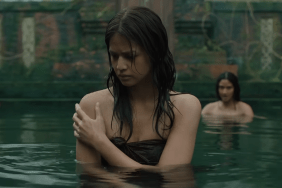
SHOCK celebrates the ‘Grand Dame Guignol’ in film.
Thematically, horror is a womans domain. It is a female genre. Most horror movies feature women or girls as their protagonists, and this is something that should be celebrated and revered. And one thing that should be championed about the genre is that horror embraces women and girls of all ages and puts them on the front line, bringing them to the foreground be they women in their prime, teenage girls (oft-used), little girls (many a time presented as monster) and thankfully, women in their more seasoned years. The latter is what we are honouring in this here issue of Fangoria. Those grand dames of horror! Those wonderful more mature but still as vibrant and as active-as-ever legendary actresses who reclaimed Hollywood and made it their own in their later years. Superstars and revolutionaries such as Bette Davis, Joan Crawford, Olivia de Havilland, Ruth Gordon, Ruth Roman, Shelley Winters, Gloria Swanson, Myrna Loy, Piper Laurie, Debbie Reynolds, Agnes Moorehead, Yvonne de Carlo and many more, resurrected their careers during the time of their advanced age, having to leave their ingénue days behind in the Golden Age of Hollywood. Come the early 60s, these versatile and passionate talents re-entered showbiz carrying axes, sporting knives, drinking heavily and were caked up with grotesque make-up all the while screaming and clawing their way onto the silver screen as maniacal movie monsters! These older women that shaped Hollywood and were massive box office draw cards in the 30s and 40s, now got a chance to go crazy on screen, and the results are all gleefully delicious! The psycho-biddy sub-genre was born as soon as Bette and Joan had their divine feud in the American Gothic masterpiece WHAT EVER HAPPENED TO BABY JANE?, a film that brilliantly dissected the horrors of ageing in the entertainment industry, and ever since after that Warner Bros. freak show, audiences hungered for more! The beauty of these hag show horrors is that these divine divas really got a chance to cut loose and have fun being psychotic.
Here are ten essential hagsploitation movies (and one recording of a stage musical) that you simply must see:

WHAT EVER HAPPENED TO BABY JANE? (1962)
The film that ultimately started the trend! Featuring one the longest prologues in the history of cinema, Robert Aldrichs American Gothic classic sets up its two central figures as polar opposites one a brassy show business brat and the other a self-sacrificing martyr. Little Baby Jane is a superstar of the vaudeville circuit, while her sister Blanche sits in the wings watching. Singing out her key song Ive Written A Letter To Daddy, little Baby Jane Hudson wins the admiration and affection of her song-and-dance man father, while Blanche seems to be a burden. But anger brews in the equally twisted heart of little Blanche, who promises that someday shell show her sister. Years pass and the two have become successful actresses in Hollywood (the film featuring Bette Davis in all her pre-code glory), however times get tough and Jane and Blanche find themselves in a cold predicament Jane is rendered unbankable and box-office poison, while Blanche (the more lauded and talented) is in a nasty accident and left paralysed in a wheelchair. Shifting our focus to the current 1962, the sisters live in a decrepit Hollywood mansion and are locked together in hatred. Bette Davis is a knockout in this film plastered with layer upon layer of powder, eyes painted on to look like the dead dull eyes of a doll, her bleached-out hair in twisted poodle locks and her lips garishly constructed while a little love heart beauty mark sits upon her twisted, angry and bitter face she is a new kind of movie monster, one without true pathos and one that is hell bent on giving those around her a bastard of a time. She is also foul mouthed, boozy and most importantly haunted by her past as a successful child star and actress. One of the most vividly telling moments in the film is where she finds herself in the mirror after a delusional recital in her blacked out living room she catches her withered face, terrified of aging and is tormented by the image of what she has become. Following that is her handicapped sister buzzing her for some help, which escalates in Daviss Jane screaming and hollering and bitterly tending to her invalid sister. When she decides to resurrect her career and enlist the help of a struggling musical director (played by Victor Buono in a magnetic performance) the film takes on an entirely new life as ambitions, age, jealousy, mental illness, resentment and the cruel mistress that is the performing arts all come to light and bring the film to a devastating climax on the washed out beaches of California where truths are revealed and a freakish Baby Jane Hudson gets the captive audience she desperately longed for, but for all the wrong reasons. A cult favourite that, along with the noir/horror melting pot SUNSET BLVD., exposed the ugly underbelly of the throwaway machine that is Hollywood, WHAT EVER HAPPENED TO BABY JANE? is one of the most important horror films of the sixties and Bette Davis and Joan Crawford should be up on the genres mantle alongside the likes of Bela Lugosi and Boris Karloff.

HUSH HUSH, SWEET CHARLOTTE (1964)
With WHAT EVER HAPPENED TO BABY JANE? being a surprising success at the box office as well as a critically acclaimed film, director Robert Aldrich decided to reunite his two stars for another American Gothic psycho-biddy catfight. However, Joan Crawford preferred to run alongside the likes of William Castle for another hagsploitation wonder STRAIT-JACKET instead (although, she told the press that she was too ill to commit to the Aldrich movie for 20th Century Fox). Bette Davis, however, remained and delivers one of the most frantic, frenzied and psychotic performances ever put to screen in HUSH HUSH, SWEET CHARLOTTE. Even the opening credits (that follow after an equally long prologue that audiences became accustomed to with Aldrichs previous Grand Dame Guignol unexpected hit) showcase Daviss talents as a versatile and dedicated artist dramatically lit by Joseph F. Biroc and complimented by the lush music of legendary Frank De Vol (who also wrote the creepy playground taunt Chop Chop Sweet Charlotte), Bette Davis silently goes through a series of manic expressions that summarise the entire film: her descent into desperate and harrowing madness. The film makes superb use of shadow and light, and is also surprisingly gory in its depiction of beheading and bloodshed. Teaming up with Davis (in place of Crawford) is the dynamic and engaging Olivia de Havilland, an actress who stood her grounds in the heyday and worked tirelessly for the rights of fellow performers. De Havilland is outstanding as the cousin of Daviss Charlotte, and the two get to play out an incredibly engaging duel set against the lavish (and eerie) backdrop of the South. Aldrich weaves together an enriched, complicated melodramatic Southern Gothic chiller that boasts an incredible supporting cast including two more seasoned actresses Agnes Moorehead and Mary Astor. Embedded in the films thoughtful darkness and depravity is a playful shock factor, where Bette Davis as the tormented tormenter Charlotte is constantly reminded of her ex-lovers severed head this is where the film has fun with the genre and does something so perfectly executed in that it plays a tight balancing act between high dramatics and high camp.

STRAIT-JACKET (1964)
Joan Crawford screaming in delicious histrionics is enough to watch this fantastic film from horror movie shlockster William Castle! Crawford is quite honestly on top of her game here, a performance that sings with nervous energy, relentless zeal and an almost I will prove that I am the greatest and most hard working actress of the decade vibe that is almost penetrable. A fabulous opening abounds as Crawford chops the heads off her husband and his lover, beautifully shot and now iconic in horror movie history. Years later, and after some supposed rehabilitation she is reunited with her daughter who welcomes her mother back home with open arms. However, things get messy when Crawford decides to win the heart of her daughters young beau, which in turn wakes up a monstrous malevolence that will ultimately end in more bloodshed and more manic behaviour. But of course, in classic William Castle style (and boy does he have style!), the murders might not be at the hands of Crawford but someone else! Crawford started off her career as a hoofer in backstage movie musicals at MGM (however she was most certainly no Eleanor Powell in the dance department), then worked her way into becoming the every woman and the working class shop girl with the heart of gold in multiple womens pictures. However, when she was eventually cast in the phenomenal THE WOMEN, she got to shine as a catty, narcissistic, man hungry glamour queen and this stuck for many years. But come the early 60s, Crawfords transition from high and mighty sexy bitch to monstrous psychotic was in clear form come the production of STRAIT-JACKET. A role that she would continue to enjoy with films such as BERSERK! and I SAW WHAT YOU DID.

SUDDENLY, LAST SUMMER (1959)
SUDDENLY, LAST SUMMER, based on the one act American gothic play by Tennessee Williams, is most definitely one of the strangest horror movies to come out at the tail end of an era obsessed with big bugs and black lagoons. It has all the beautiful trappings and storytelling devices usually associated with classic monster pictures of the thirties but is grounded in ostentatious melodrama – sick and demented melodrama dealing with confronting subject matter that the Production Code was completely terrified of. Although the Production Code was concerned with the film regarding its taboo subject matter such as homosexuality, incest, rape and cannibalism, the Catholic Legion of Decency gave special permission to the MPAA for it to be made. The Catholic Church explained that although this film dealt with a sexually deviant character (a man who slept with other men) it would be considered moral because it showed the horrors of such a deviant lifestyle and what can result (being eaten alive literally!). Many films that dealt with gay characters explicitly in the 50s shared similarities with monster movies of the time. The gay character was an alien aberration against God and against nature, not only alien to polite society but to the family of which he/she came. If you compare FRANKENSTEIN or its sequels with SUDDNELY LAST SUMMER the last moments in those films are very similar: Frankensteins monster/Sebastian Venable is lynched by an angry mob and destroyed for the good of society. He is an unnatural creature, a thing that shouldnt have happened. Much like Colin Clive in FRANKENSTEIN, Katherine Hepburn is the mad creator of a monster; the mother of a fey homosexual, the archetypal deranged scientist who has created this abomination. I include this in my list because of Katherine Hepburn. She is a stand out in this film. Her grand entrance, descending in an open-view elevator, mid-flight in conversation is just one of the greatest horror movie entrances ever. Her descent into madness is just a treat to watch and her most endearing (and scary) moments all occur in the lengthy but eternally captivating scene in Sebastians garden. This is just sheer devilish decadence. She is frightening from the get go with her serpentine tongue delivering some of the most memorable dialogue in the film. She revels in her lascivious leering as she introduces Montgomery Clift to her carnivorous plant life, she makes us feel downright uncomfortable when she continually boasts about her unhealthy devotion to her darling dead boy and most insanely terrifying of all is her recount of the horrific tragic deaths of the baby sea turtles on the Spanish beach coast who are devoured by bloodthirsty birds – a beautiful parallel (and delusional recapping) of the violent gore-fest that was Sebastians demise!

WHATS THE MATTER WITH HELEN? (1971)
Debbie Reynolds and Shelley Winters star in this period piece about two mothers teamed up by circumstance when their sons are arrested for a Leopold and Lobe-style series of murders. Reynolds is a knockout in this film she is an absolute treat to watch. This gorgeous heroine of Hollywood history and superstar of the Golden Age of the movie musical, comes with guns blazing in this creepy horror film that boasts some lavish art direction, some stellar musical numbers and one of the most memorable nutsy performances from co-star Shelley Winters. These two actresses tear it up on the screen, and under the swift direction of Curtis Harrington (who at this time was being dubbed horrors answer to George Cukor because of his fantastic ability to direct and understand women) the film is brimming with desperation, maudlin menace and on Winters part a sickly lesbianism that would gradually resurface in nasty thrillers such as WINDOWS. With horrific imagery such as the crazed Shelley Winters chopping up her pet bunny rabbits, then eventually stabbing Debbie Reynolds to death and keeping her corpse propped up like a grimacing mannequin, the film is a superb play on the idea of celebrity, the cult of child stars and the creepy relationship shared between stage mothers and tap dancing, endlessly grinning showbiz children. Much like the musical GYPSY (an inspiration for Harrington) which examined the monstrous relationship between Rose and her stripper-to-be daughter, WHATS THE MATTER WITH HELEN? takes the dark edge of theater and film and marries it with a straight up parlor room horror show.

WHOEVER SLEW AUNTIE ROO? (1971)
American International Pictures got on the bandwagon with the pscyho-biddy trend with this deliciously demented play on the Hansel and Gretel tale. Shelley Winters plays Rosie Forrest (known to the neighbouring children as Auntie Roo), an American outsider in a small provincial English town, who at first is seen as a lonely old widow who loves the company of children and who throws a lavish Christmas party every year for the orphans who are thrilled to treat themselves to her gingerbread men and generous gift-giving. However, the British public soon grow suspicious and thoroughly worried, as things take a macabre turn for the worst. Mark Lester (fresh from the hugely successful OLIVER!) is a savvy little boy and discovers Auntie Roos plans are not at all wholesome or genuine, and that she is in fact a psychotic harridan wishing to replace Lesters sister with her mummified own dead daughter. Winters really gets to sink her teeth into a crazed madwoman, who doesnt shy away from fighting off little Mark Lester with a plank of wood! Interestingly enough, this is one of the only Grand Dame Guignol films that didnt pit one woman against another instead the film borrows more from the traditional witch model. The film is worth it alone for Winters performance of vaudeville classic Tit Willow and the unsettling image of her mummified daughter who crumbles at the point where Roos plans are uncovered.

WHAT EVER HAPPENED TO AUNT ALICE? (1969)
Making excellent use of Arizona desert land, this fun ride pits Geraldine Page and Ruth Gordon against each other in a battle of wits and mind games. Gordon of course wowed audiences as the Satanic neighbour to Mia Farrows Rosemary in the horror masterpiece ROSEMARYS BABY which revolutionized the way people thought about horror and also provided a wonderful opportunity for elderly actors and actresses to play roles that arent simply sweet natured grandparents here the elderly were the monsters of the piece. And Geraldine Page plays the cantankerous widow here ever so well with her urban pretensions, her perpetual nasty disposition and irritability that grows and grows. The plot involves Page hiring elderly housekeepers who she cons out of their money before she kills them and buries them in her precious garden. Based on the novel The Forbidden Garden by Ursula Curtiss, the film is not as fevered as its earlier hagsploitation predecessors such as WHAT EVER HAPPENED TO BABY JANE? or HUSH HUSH, SWEET CHARLOTTE, but it does share two major similarities it features two mature divas that tear at each others throats and a lengthy, provocative title.

FLOWERS IN THE ATTIC (1987)
Relentlessly trashy and proud of it, this adaptation of writer Virginia Andrewss novel is a monstrous affair loaded with sickly imagery such as malnourished children, borderline (and blatant) incest and bloodletting all set to oppressive themes such as child abuse. Trying to embrace the American Gothic tradition, but being let down by flat-liner direction, the movie is not the most attractive or even interesting, however Louise Fletchers performance as the stern, ready-to-be-hated grandmother is too much fun to ignore. She is outstanding in her uncompromised evil and has no shame in being a one dimensional caricature. And honestly, there is absolutely nothing wrong with that. Not every performance or character has to be carefully nuanced or complex in construction, sometimes playing the dastardly villain is more than enough and Louise Fletcher with her hair tightly pulled back in a bun, and dressed in her sensible black dress and buckled shoe, is absolutely captivating. Her remarkable meanness leads her to chop off the hair of the teen heroine, lift up one of the young children by the head and poisoning. An unremarkable film, but a stunning performance from Fletcher who seemed to have never been able to shake off the atypical bitch role in Milos Formans analogous ONE FLEW OVER THE CUCKOOS NEST as Nurse Ratched, who came to represent stoic and unfeeling authority. Here in FLOWERS IN THE ATTIC, it is more of the same thing, however without the social commentary.

SWEENEY TODD: THE DEMON BARBER OF FLEET STREET (stage musical 1979)
Stephen Sondheims magnificent blood soaked musical about the worlds most infamous throat slitting barber is made all the more electric by the superb Tony Award winning performance of Angela Lansbury as the amoral, opportunistic Mrs. Lovett. Lansburys sublime handle on Sondheimian patter and incredibly complicated musical phrasing is extraordinarily executed with such precision and heart, that it is very hard not to fall in love with this creepy denizen of depravity. Set in industrial-era London where everyone scrambles for a living, the musical (the most operatic of the Sondheim catalogue in that there is hardly any book, and mostly song) is part rape-revenge, part cannibalistic, part Grand Guignol and mostly a celebration of misanthropy. Mrs. Lovett epitomizes this disdain for the human condition as she suggests that Sweeney Todds sliced up victims are turned into pies and served to the hungry citizens of London town. The monstrous Mrs. Lovett also hides a secret from Sweeney for selfish reasons as she wishes to keep the murderous barber for herself, and Angela Lansburys climactic plea before she is thrown into the oven to burn is both despicable and heartbreaking. Songs such as My Friends featuring some remarkable harmonies from Lansbury and co-star George Hearn as Sweeney, By The Sea which is brightly thrown about but with a biting undertone and Not While Im Around which is complimented by off-strings that accompany Lansburys twisted lies are stand outs.

THE BABY (1973)
Completely brilliant but also utterly messed up, this is a film that has to be seen to be believed! This creepy bizarre flick tells the story of a social worker who infiltrates a household dominated by the fabulous Ruth Roman. An actress that made her mark as a tough as nails broad in westerns and thrillers in the 50s and 60s, Roman is magnificent as the matriarch of this wacko abode. With her breathy almost-Liz Taylor type swagger and her guttural sauciness, she and her two nymphet daughters protect their man-baby that lives with them. Yes, thats right, Ruth Roman has an adult son who she keeps as a fully grown baby and yep, hes even referred to as Baby! Her violent outrage at a babysitter who takes to breastfeeding the grown man-bubba is one of the 70s most outrageous moments in cinema, with Ruth Roman beating the living daylights out of the girl with her two equally violent daughters viciously attacking as well. The final showdown is pitted against Roman and the social worker who has her own ulterior motives surrounding the liberation of Baby. Roman went on to be terrorized by animals affected by the damage in the ozone layer in William Gridlers opus DAY OF THE ANIMALS and she gets to butt heads with the likes of a truly repugnant Leslie Neilsen, but here in THE BABY she runs the show and keeps herself on the handle of controlling her infantile adult son.
Note: Portions of this feature appeared in print in FANGORIA #343.









